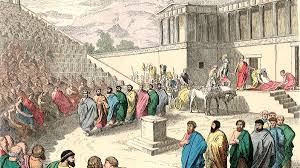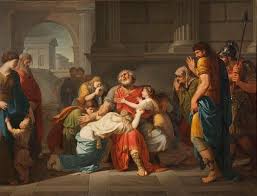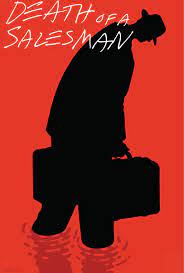
What is a tragedy? “To be or not to be’’. In the postmodern world of today, with advanced technology and complexities, where life has become synonymous with suffering, tragedy is nothing but the existence of life. Life has touched everyone, and so has tragedy, regardless of one’s social class. In the past, tragedy often arose from a latent flaw, known as “hamartia,” typically associated with the elite class or a revered hero. However, to err is human, and to have flaws is inherent to our humanity. With this in mind, tragedy has been a part of the human experience since its inception, but the recognition of it came later, probably in the modern and postmodern era. In literature through drama, novels, and other forms, tragedy is depicted in various ways to portray the realities of life. Its conception has evolved, from characters to settings.
Let’s explore how tragedy evolved through various ages and when humans have become conscious of this collective suffering happening unbiasedly to all.
In literature, the history of tragedy dates back to Greek.  Following the rituals of the Greek god Dionysus, Aristotle was the first one to define tragedy properly. According to Aristotle, “Tragedy is an imitation of an action that is serious, complete, and of a certain magnitude… through pity and fear affecting the proper catharsis of these emotions.” Similarly, the tragic hero of a tragedy is a man of high fortune whose downfall originates from his inborn flaw. However, as a character, he must fall between the two extremes of good and evil. He is neither purely evil nor good. For Greeks, tragedy was a ritual performance that aimed at the purgation of emotions to have a better democratic society. There was little to no space for tragedies of the Common man in Greek tragedy. Oedipus Rex by Sophocles has everything that a Greek Tragedy characterizes.
Following the rituals of the Greek god Dionysus, Aristotle was the first one to define tragedy properly. According to Aristotle, “Tragedy is an imitation of an action that is serious, complete, and of a certain magnitude… through pity and fear affecting the proper catharsis of these emotions.” Similarly, the tragic hero of a tragedy is a man of high fortune whose downfall originates from his inborn flaw. However, as a character, he must fall between the two extremes of good and evil. He is neither purely evil nor good. For Greeks, tragedy was a ritual performance that aimed at the purgation of emotions to have a better democratic society. There was little to no space for tragedies of the Common man in Greek tragedy. Oedipus Rex by Sophocles has everything that a Greek Tragedy characterizes.
Following the footsteps of Greek tragedy, medieval-era tragedies were less and more the same. Tragic heroes tend to be the noble, elite men of the society. Likewise, the hamartia concept was repeated. With Shakespeare, the tragedies kept on looming around the Kings and princesses. However, their themes and presentation were more powerful in making a lasting impact on the masses. Many could see their reflection in falling characters. His unmatchable and unforgettable tragedy, Hamlet aptly describes his tragedies.
The true revolution in tragedy occurred with the advent of the modern era. Arthur Miller played a pivotal role by introducing the Common man as a central figure in tragic narratives. According to Miller, the Common man is the most suitable subject for tragedy. In his view, the tragic flaw lies in the characters’ unwillingness to yield when faced with challenges that threaten their integrity or dignity. In many of such modern tragedies, a middle-class individual takes center stage due to their relevance for the audience. Death of a Salesman serves as a classic example of a modern tragedy, where the downfall of the salesman character symbolizes not only the personal failure of a middle-class individual but also reflects the shortcomings of the broader economic and political system.
Arthur Miller played a pivotal role by introducing the Common man as a central figure in tragic narratives. According to Miller, the Common man is the most suitable subject for tragedy. In his view, the tragic flaw lies in the characters’ unwillingness to yield when faced with challenges that threaten their integrity or dignity. In many of such modern tragedies, a middle-class individual takes center stage due to their relevance for the audience. Death of a Salesman serves as a classic example of a modern tragedy, where the downfall of the salesman character symbolizes not only the personal failure of a middle-class individual but also reflects the shortcomings of the broader economic and political system.
Jumping into the postmodern era literature, themes of postmodern tragedies have diverted to common men. With the increasing mental complexities, subjects and forms of tragedies have become much more diverse. Back then, tragedies were part of rituals performed on stage. Besides, previously, they were written in play format. However, with changing times, tragedies as a subject and an aspect have become part of novels, short stories, and long narrative poems. For example, Anna Karenina, The Fault in our Stars, etc.
Hope you have a brief idea of how tragedy evolved from a ritual to a literary aspect across different forms of literature. If you are intrigued about the forms and types and would like to know more then we have a few of our favorite websites that could quench your thirst.
https://www.britannica.com/art/tragedy-literature
https://interestingliterature.com/2013/05/a-brief-history-of-tragedy/






Comments (3)
melodysays:
December 12, 2024 at 11:15 pmGreat bⅼog! Ιs your theme custom made or dіd yoᥙ download it from somewhеre?
A design like yours with a feѡ simple adjustements would really make my blog jump out.
Ⲣlease let me knoᴡ where ʏou got your design. Thanks a lot
fijiansays:
December 13, 2024 at 11:25 amᎢhis is a great tip particularly to those fresh to the blogosphere.
Simple but very pгecise info… Appreciate your sharing this one.
A must read post!
affordsays:
December 16, 2024 at 10:53 amThank you a ⅼot for sharing this with all folks you really understand what you are talking about!
Bookmarked. Kindly also discuss with my web site
=). We cаn have a link аlternate agreement among us